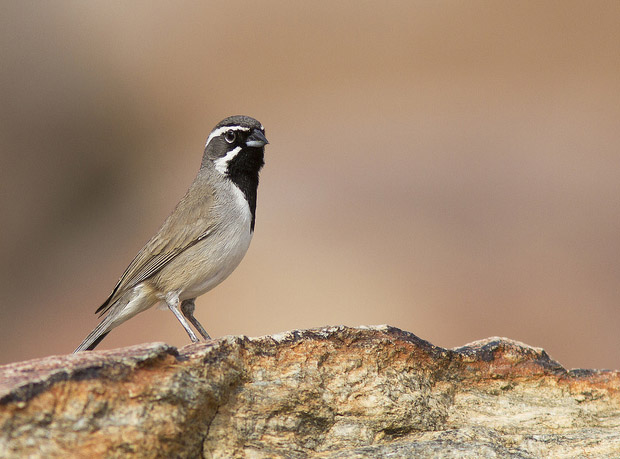
Bird photography can be frustrating at times, and it may seem like you always need a longer lens, but with a little patience and a few little tricks, you’ll be coming home with good bird photos in no time. So, here are a few tips to get you started:
#1 – Photograph them in direct sunlight
This isn’t always a requirement, but it’ll help you get a faster shutter speed (which helps freeze the bird’s sudden movements and increases your chances of getting a sharp photo as you’ll likely need to handhold your camera). And, the direct sunlight also helps you avoid those ugly harsh shadows which usually cause exposure headaches.
#2 – Wait for them to come to YOU
If you try approaching a bird, you’ll almost always scare it away well before you get close enough to fill even 10% of the frame. Even if you try to move as slowly and quietly as possible. But, if instead you just sit somewhere and wait for the birds to come to you, they’ll often get pretty close. Sometimes they’ll even get too close! Just be patient!
#3 – Use a blind or avoid sudden movements
Birds (and any wildlife) are extremely sensitive to movement, so if you make any sudden movements you’ll likely scare the bird away. Ideally, you should wait for the birds from a blind (to completely mask your movement). But, if a blind isn’t available, then try to be as still as possible.
#4 – Find a spot with a lot of good perches
When you’re looking for a spot to sit and wait for the birds to come to you, you should be looking for a couple of things. First, you obviously need a place with some good bird traffic 
#5 – Use a monopod or tripod for support
You won’t have time to lock in the ballhead on a tripod, but you can still keep it unlocked and use the tripod legs for some added support. Or, you can invest in a lightweight monopod. Keeping your camera still will increase your chances of getting a tack sharp photo.
#6 – Enable rapid shooting and take lots of photos
You’ll want to take a lot of photos rapidly for a couple of reasons. First, the bird will likely make a lot of sudden movements so you want to ensure you photograph him/her when they’re standing still in a good pose. And, second, since you’ll be somewhat hand-holding your camera, taking lots of shots will increase your chances of getting a sharp one.
#7 – Set your autofocus point to the center spot
Most lenses will autofocus the fastest in the center of their view, so set your autofocus point to the center spot. And, focus on the bird’s eyes because that’ll be the first place the viewer looks in the photograph. It’s critical for the eyes to be tack sharp.
#8 – Set your lens to autofocus on far objects
In a previous post, I mentioned how you can flip a little switch on your telephoto lens to make it autofocus faster on far objects. The switch basically tells your lens to only worry about focusing on far objects, and not waste time on close stuff.
#9 – Watch and learn about their behavior
When you’re out there sitting and waiting for birds to get close enough to photograph, take that time to observe other birds and look for patterns. Or better yet, read some books about them too. Learning more about their behavior can help you predict what they’ll do in certain situations. Or, for example, you’ll learn that some species will continually return to the same perch, offering you a pretty easy opportunity for a photo.
What did I miss?
Do you have another tip for photographing perched birds? If so, please share it with us by leaving a comment below. Thanks!
If you enjoyed this article, and would like to read more, please signup for free updates by email or RSS.
 About the Author: Steve Berardi is a naturalist, photographer, computer scientist, and founder of PhotoNaturalist. You can usually find him hiking in the beautiful mountains and deserts of Southern California.
About the Author: Steve Berardi is a naturalist, photographer, computer scientist, and founder of PhotoNaturalist. You can usually find him hiking in the beautiful mountains and deserts of Southern California.
Most of my bird photography happens in my backyard. I found when I added a bird bath my variety went up and as did number of visits. I also added a few bird houses last year and was lucky enough to get a wren to raise her new family in it.
Biggest tip is patience. Most of the time I find if I just sit and watch for awhile the birds become used to you and realize you are not a threat.
Great stuff, thanks. Been starting to shoot local birds too. Challenge is keeping depth of field broad enough for the subject but blurred enough for that soft background. Folks have birdfeeders all over the place here too and that helps.
Nice article Steve,
what do you thing abt metering method which one gives nice results.
I’m not sure exactly what you mean by direct sunlight. Do you mean front sunlight as opposed to overhead, side or back sunlight?
@ardit – I usually calculate the proper exposure beforehand, using the histogram (also check out this post on the RGB histogram).
@George – Yeah, by “direct sunlight” I mean the bird is front lit by the sun. If the sun is overhead or to the side of the bird, then you’ll usually get some harsh shadows. And depending on the colors of the bird, those harsh shadows can cause exposure problems.
Great advice Steve. I just wanted to add that if don’t want to carry a blind, a good camo pattern from head to toe works great. I get excellent results with just camo and slow deliberate movements. A good handfull of seed doesn’t hurt. Check out my flickr sight to see some very close shots.
Thanks for all of the great guidance. I agree with everyone’s thoughts, they all work. In my shooting I try to keep hidden the feeders and bath. Nothing wrong with feeders and baths (I use both) I have inserted the bath in ground level and added a few stones, now it looks like a small natural pool, same with the feeder. I try to keep all of the pictures as natural as possible, seems to be more pleasing to the viewers eye.
We feed and water the birds a squirrels year round, so we figure a couple of pictures can be posed for. Oh one last Tip, we have a Golden Retriever “Bird” dog who stays at my side until those pesky birds get in the way of her new drinking dish and then she mustchase them off and give them a good barking as well, some understand some will not.
Good Birding
Thanks for both this and your birds in flight articles. They are helpful and clear. I have added both of them to the list of birding photosites at Natural History Wanderings:
http://naturalhistorywanderings.com/2010/12/07/bird-photography-tips-2/
@George – Good call on the camo pattern. I actually use that Kwik Camo stuff whenever I’m photographing hummingbirds. It works pretty well, and it’s lightweight and doesn’t take up too much space.
@Sandy – Thanks for the link!
Following the tips, trying new things, I’ve posted some new photos from the neighborhood. jlarrygolferphotography.blogspot.com. Be interested in any comments, critiques.
George,great article and all around site!! Additional tips that I would recommend for photographing perched birds is to try and get eye level with them. For me the focus point is always on one of the eyes, moving the focus point to ensure I can get the entire bird in the frame. That is another key, I always try to set up in my blind or hiding spot so that I am close enough that when the birds do show up I am close enough that they fill the frame. Last but not least I try to wait until the bird is getting natural eye-catch from the sun. It is amazing what a little bit of sparkle in the eye does for the overall image.
Good tips. I think the most important thing you mentioned is to get that eye as sharp as possible. One thing I would add is to get good at pishing and squeaking to get the birds to come closer to check you out.
When background is all clouds or overcast white sky, there may be some back light. I play with exposures to brighten the sky to white. Anna
I do most of my photography in Africa and the Algarve in Portugal. Very bright, light with a huge glare factor. I usually have to “over expose” by up to 2 stops to compensate and not get black birds when I’m not photographing Blackbirds!
It’s an idea when photographing the birds that “hawk” for prey, such as bee eaters, to remember that they always land on their perches facing into the wind. This helps you to choose a position where out spread wing shots are more likely.
I really enjoy your tips Steve, nice and clear, straight forward and not cluttered with techno jargon.
Jim
Why did you cut off the sparrow’s feet? Poor bird!
Good article Steve. I might add that one should use a wide aperture to minimize the background detail and pre-focus on the previous perch. Birds are creatures of habit and often return to the same perch (as do dragonflies), and by doing this you can often fire off a shot quickly before it jumps to another branch. When travelling, I often park my car well off the left side of side road and place a bean bag on the window sill to steady the camera. The car can make a perfect blind, but movement must still be slow within the vehicle. I parked myself in an empty parking lot this Spring where I knew California Quails nest, and after a 10 min wait, sure enough the family came out… only a few metres from my driver’s side window. The Quail chicks are the size of a golf ball, so the need to be close is important. After getting several shots I slowly brushed a mosquito off my forehead and they scattered. Had to start the whole process again!
Steve, your photography is quite inspiring my friend. Also, it is explained in ways that even I can absorb it all. Thank you for all you do…
Stephen L. Winn
Great tip by Frank Townsley also on prefocusing on perches commonly used. For those of us that do not have a switch on the lens this is an easy method to have a better chance of success. Shooting Eagles flying in the tailwaters of Kentucky and Barkley dams I prefocus on gulls or herons to finding the best distance to work with. Then I am set when the eagles cross that path. Resulting in more quality captures.